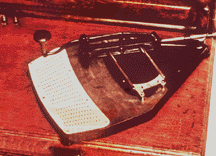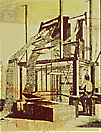As early as 1884, Herman Hollerith, an engineer from Columbia University had been toying with machines -- both electrical and pneumatic -- that could compile statistical information.
He entered his machines in a competition held by the Census Bureau in 1889 to determine which of all available methods would be best for the next census. The Hollerith Electrical Tabulating System was the overwhelming winner.
 (9)
(9)
.
All information pertaining to an individual was punched into a single card.
The card was then placed in the sensing mechanism of the tabulator, which had one pin for each possible position on the card. Where there was a hole in the card, the pin would pass through, connect with a bed of mercury beneath the sensor, and effect an electrical contact.
This would advance by one position one of forty counters on the tabulator.
The tabulator could be wired so that different information could be counted at each pass of the card though the machine. Hooked up electrically to the tabulator was the sorter box. At the same time, the sensor advanced the counter, an appropriate box on the sorter would be activated and the lid would pop open. The operator would place the card in the appropriate box and proceed to the next card.
Although slow by today's standards, this was exactly what was needed to make order out of the uncontrolled mass of data.
For all Hollerith's success and all the praise heaped on the Census Bureau, the newspapers complained bitterly when the population was less than expected and New York State lost two representatives. Following the US Census, Austria and Canada used Hollerith machines for their own censuses. In 1895, Hollerith went to Moscow to sell his machines to the Russians for their first census.
 (9)
(9)
.
Babbage had planned to program his Engine with cards, but Hollerith turned the small piece of cardboard into a key to wide-scale data processing.
![]()
| Last Updated on 18 February, 2004 | For suggestions please mail the editors |
Footnotes & References